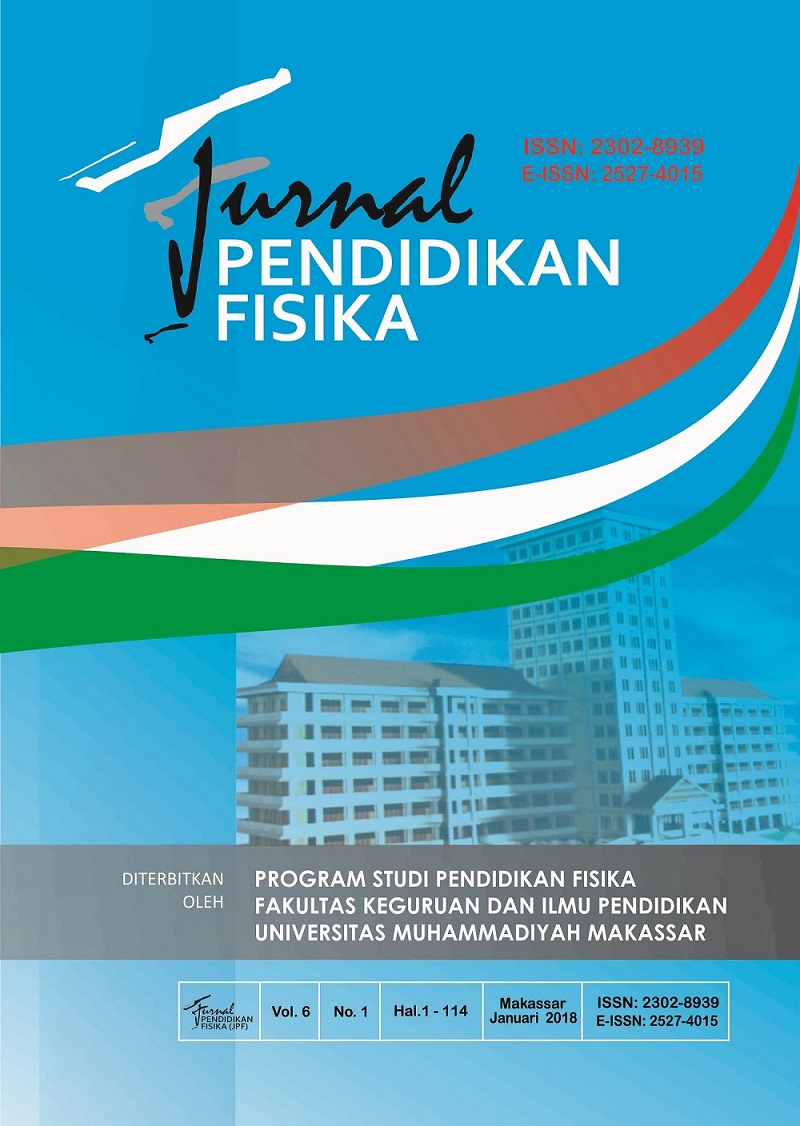Pengembangan Alat Peraga Fisika Berbasis Internet of Things untuk Praktikum Hukum Newton II
DOI:
https://doi.org/10.26618/jpf.v6i1.956Abstract
The research purpose is create a physics props of Newton’s Second Law based on internet of things (IoT).The product consists of slippery and rough flat field, photogate sensors, control system box, audio cable, and NewtonApp application. The result shown that developed physics props got very good and feasible appraisal according to all experts.
References
Borg, W.R. dan Gall, M. 2003. Educational Research 4th edition. Longman Inc., New York.
Chen, S., Hao-Chang, L., Jing-Wen, L., Jyh-Chong, L., Chin-Chung, T., Ying-Tien, W. 2012. “Development and implications of technology in reform-based physics laboratories”. Phys. Rev. Phys. Educ. Res., 8, 1-12.
Dare, E.A. dan Roehrig, G.H. 2016.”If I had to do it, then I would: Understanding early middle school students’ perceptions of physics and physics-related careers by gender”. Phys. Rev. Phys. Educ. Res., 12, 1-11.
Dasriyani, Y., Hufri, Yohandri. 2014.”Pembuatan Set Eksperimen Gerak Jatuh Bebas Berbasis Mikrokontroler dengan Tampilan PC”. Jurnal Saintek., 6(1), 84 – 95.
Espressif systems IOT Team. 2015. ESP8266EX Datasheet version 4.3. diakses di bbs.espressif.com pada tanggal 19 September 2016.
Farida, H. dan Yusro, A. C. 2016. “Pengembangan ODD ‘Osilator Digital Detector’ sebagai Alat Peraga Praktikum Gerak Harmonik Sederhana”. Jurnal Inovasi dan Pembelajaran Fisika, 1-7.
Hake, R.R. 2007. Design-Based Research in Physics Education: A Review. NSF Grant DUE, Erlbaum.
Hong, H.-Y. dan Lin-Siegler, X., 2011.”How Learning about Scientists” Struggles Influences Students’ Interest and Learning Physics”. Journal of Educational Psychology., 10, 1-17.
Irwan Padli, M.”Strategi Pembelajaran Efektif Berbasis Mobile Learning pada Sekolah Dasar”. Jurnal Iqra’. 10(1), 1-14.
Junaidi, A. 2015. “Internet of Things, Sejarah, Teknologi, dan Penerapannya: Review”. Jurnal Ilmiah Teknologi Informasi Terapan, 1, 62-66.
Marusic, M. dan Slisko, J. 2012.”Effects of two different types of physics learning on the results of CLASS test”. Phys. Rev. Phys. Educ. Res., 8, 1-12.
Meutia, E.D. 2015. “Internet of Things- Keamanan dan Privasi”. Prosiding Seminar Nasional dan Expo Teknik Elektro, 85 – 89.
Nursaila, S. dan Ibrahim, F. 2016. “Rapid Prototyping of Newton’s Law Educational Games”. International Journal of Education and Research, 4, 83-92.
Olasimbo, O.O. dan Rotimi, C.O. 2012. ”Attitudes of students towards the Study of Physics in College of Education Ikere Ekiti, Ekiti State, Nigeria”. American International Journal of Contemporary Research., 2(12), 86-89.
Serway, R. A. dan Jewet, J. W. 2004. Physics for Scientists and Engineers sixth edition. Thomson Brooks, Cole.
Sukarna dan Sutarman. 2014.”The Development of Light Reflection Props as a Physics Learning Media in Vocational High School Number 6 Tanjung Jabung Timur”. International Journal of Innovation and Scientific Research., 12, 346-355.
Sulisworo, D. 2016. "The Contribution of the Education System Quality to Improve the Nation’s Competitiveness of Indonesia." Journal of Education and Learning (EduLearn) 10(2), 127-138.
Sulisworo, D. 2015. “Conceptual model identification of personal learning environment”. In: International Joint Seminar on School Administration and Multicultural Society, 25-26 April 2015, Songkhla, Thailand, 30-35.
Tipler, P. A. dan Mosca, G. 1997. Physics for Scientists and Engineers fifth edition. California.
Trivedi, R. dan Sharma, M. P. 2013.”A Study of Students’s Attitude towards Physics Practical at Senior Secondary Level”. International Journal of Scientific and Research Publication, 3(8), 1-4.
Wang, C., Daneshman, M., Dohler, M., Mao, X., Hu, R., dan Wang, H. 2013. “Guest Editorial Special Issue on Internet of Things: Architecture, Protocols and Services”. IEEE Sensors Journal, 10, 3505 – 3508.
Yvette, E. G., dan Haeng-Kon, K. 2015. “Integration of Wearable Monitoring Device and Android Smartphone Apps for u-Healthcare Monitoring System”. International Journal of Software Engineering and Its Applications, 9(4), 195-202.
Downloads
Published
Issue
Section
License
Copyright:
Authors who publish with this journal agree to the following terms:
1. Authors retain copyright and grant the journal right of first publication with the work simultaneously licensed under a Creative Commons Attribution-ShareAlike 4.0 International License that allows others to share the work with an acknowledgement of the work's authorship and initial publication in this journal.
2. Authors are able to enter into separate, additional contractual arrangements for the non-exclusive distribution of the journal's published version of the work (e.g., post it to an institutional repository or publish it in a book), with an acknowledgement of its initial publication in this journal.
3. Authors are permitted and encouraged to post their work online (e.g., in institutional repositories or on their website) prior to and during the submission process, as it can lead to productive exchanges, as well as earlier and greater citation of published work.
Licence:
Authors are free to:
1. Share: Copy and redistribute the material in any medium or format
2. Adapt: Remix, transform, and build upon the material for any purpose, even commercially.
The licensor cannot revoke these freedoms as long as the authors follow the license terms, which include the following:
1. Attribution: You must give appropriate credit, provide a link to the license, and indicate if changes were made. You may do so in any reasonable manner, but not in any way that suggests the licensor endorses you or your use.
2. ShareAlike: If you remix, transform, or build upon the material, you must distribute your contributions under the same license as the original.
3. No additional restrictions: You may not apply legal terms or technological measures that legally restrict others from doing anything the license permits.
Jurnal Pendidikan Fisika is licensed under a Creative Commons Attribution-ShareAlike 4.0 International License.

